Getting a new set of wheels for your toddler should be an easy task, but it turns out there are so many things to consider! Just like other parents, you are probably wondering if it’s best to get a balanced bike, pedal bike with stabilisers, or maybe invest in a tricycle stroller combo. What is the best option and when it’s the right time to get a new vehicle for your kiddo?
In this article I will compare training wheels vs balance bike vs tricycle stroller. I’m going to show you all advantages and limitations of each, so you could decide what’s best for your child.
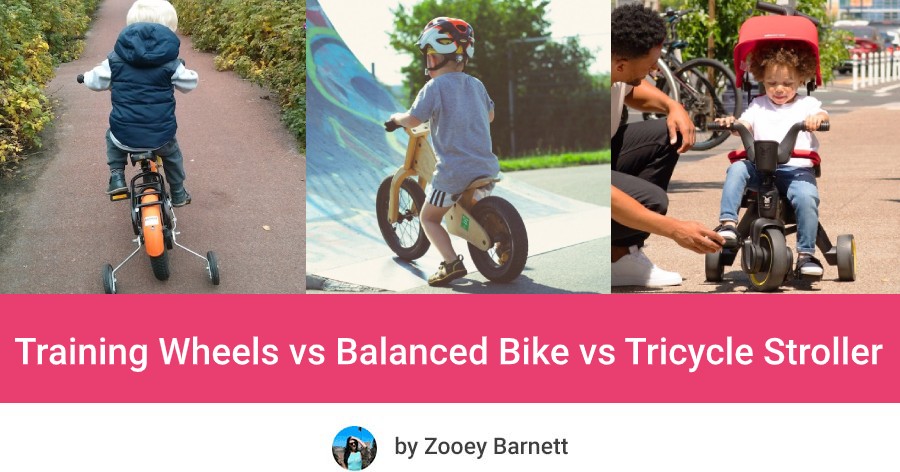
If you’re in your 20s or 30s, you most likely learned to ride a bike using training wheels, also called stabilisers. I remember that riding a pedal bike with stabilisers was so easy to me, and when my parents took them off, it was SO DIFFICULT! I felt like I had zero balance and my coordination wasn’t developed yet, so I fell off that bike many times and every time got home with scrapped knees and a few new bruises.
Thankfully, for my kids (and yours too!) there is better and easier way to learn to how to cycle now. There is this ingenious invention called balance bike, which a toddler can start using at the age of 1.5-2 years! It has been really popular in the last couple of years and it’s turned out to facilitate cycling lessons.
Another fantastic option is a stroller trike combo – which basically is a tricycle with reclining seat, canopy and parent handle – just like a stroller. Some (like Bentley 6in1 tricycle) can be used from 6 months in the “stroller mode” with seat facing parents. Then, step by step, it converts into a tricycle. You can find my list of the best tricycle strollers here.
Let’s dive deeper into our comparison and see what exactly a balanced bike, a pedal bike with stabilisers and a stroller trike are, and what are the main differences between them.
Pedal Bike With Stabilisers (Training Wheels)
Simply put, this is a kids bike with pedals, chain, brakes and cranks, with additional set of small wheels attached at the back for added stability. All pedal bikes should have one or two (front and rear) brakes.
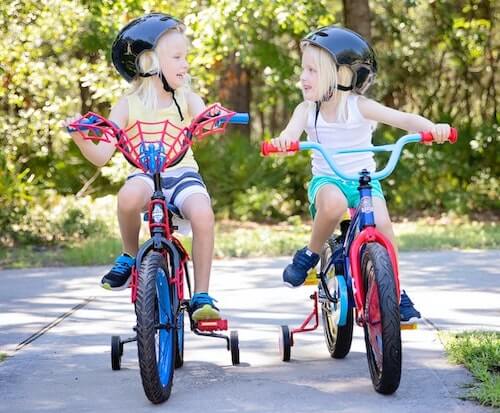
This type of bike grows with the child – you can start using it when your toddler is tall enough to pedal on his own, and then remove the stabilizers when he’s ready. If the saddle and handlebar heights are adjustable, such a bike may serve your child for a few years.
Here the child learns to pedal first, but doesn’t develop balance and coordination. The stabilisers always keep the bike upright and stable. The child feels secure and confident, because he can ride a bike without the need to balance it, because the training wheels are doing this for him.
For many years parents were teaching their children to cycle using training wheels, so why out of a sudden stabilisers are deemed to be so bad?
First things is that once the training wheels are detached, the child immediately needs to learn balancing – which is much more complicated skill than pedaling.
Moreover, now the kid has to develop the balance, WHILE pedaling, which is pretty difficult task (hence so many crashes, bruises and scrapped knees). Obviously, when you take off the stabilisers, it may be also pretty scary for the child when suddenly he/she needs to cycle independently, without having the necessary skill – balance.
Another thing that you need to know about kids pedal bike with stabilisers is that it may teach the child bad habits, which will be difficult for un-learn once the training wheels are taken off.
According to LittleBigBikes1, a company that designs balance bikes, cornering on a pedal bike with stabilisers is not only more difficult, but also makes the bike to “lean away from the corner onto their outside wheel”. Because of that the child learns to lean the wrong way. Once you remove the stabilisers, learning to cycle is even more harder!

It’s noteworthy that stabilisers add extra unnecessary weight. Considering most of kids pedal bikes are pretty heavy (most of them are made of steel, aluminum bikes are a rare thing), additional wheels make it even more clumsy and difficult to maneuver.
And let’s be honest, usually there stabilisers are small and made of hard plastic, the tire is rubber or EVA foam, but very, very thin. They often make rattling noise, can’t go over soft ground or rougher terrain. Usually the mounting brackets bend which makes the bike lean to one side (all bike with stabilisers that I’ve seen had only one wheel touching the ground).
Another issue with pedal bikes with training wheels is that unfortunately most of them have bad gearing which make turning the pedals harder. And if the bike is made of steel, plus when you add the weight of training wheels, it may turn out that it’s really difficult for the kid to get going.
The last thing that you should keep in mind is the saddle height. When you’re sitting on the saddle on your bike, you reach to the ground with your toes, right? You probably feel confident and don’t worry about tipping over.
With a pedal bike with stabilisers it’s the same, the child reaches the ground with tip-toes (in order to pedal easily and so the pedals don’t hit the found), but remember that he doesn’t have the balance skill developed yet. In general, the saddle on a pedal bike is higher than on a balance bike.
Balance Bike
You’ve probably heard about balance or running bikes which are really popular recently. According to many experts they are easier, quicker and safer option for children to learn how to ride a bike. You may now be wondering what’s so special about these balance bikes. Are they really so helpful for cycling lessons or is this just an over-hyped product?
Balance bike doesn’t have pedals. To make the bike moving forward, kids need to push off the ground with their feet.
As the name suggest, first thing that the child learns is balance. At first, the child sits on the saddle while walking, then starts to run, and finally glides with the feet off the ground which suggests he has developed the important skills of balancing, steering and maneuvering, and is ready to learn pedaling.
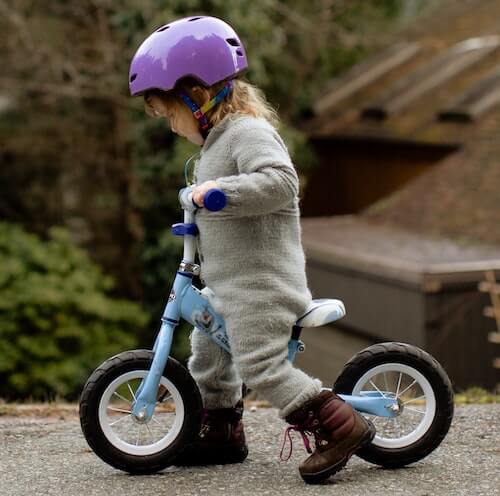
Learning to pedal is much easier and quicker, once the child has good balance and coordination.
Balance bike makes learning to cycle easier because the child actually learn that the bike steers by leaning.
Once your kiddo has developed balance, he doesn’t have the fear of tipping over and falling from the bike. For some kids it takes 15 minutest to get used to pedals!
Lots of parents and baby gear experts agree that balance bikes are the best way for the kid to learn to cycle.
It’s noteworthy that not all balance bikes are convertible and allow you to attach pedals. If you choose a balance bike that is not convertible (which is usually cheaper option), you will need a new pedal bike once your child has good balance and coordination and is ready to move onto “pedaling stage”.
| PRO TIP: There are good-quality convertible balance bike that have adjustable saddle and handlebar height, and allow you to change the geometry to increase the distances between the handle and saddle as the child grows and moves from the balance bike stage onto pedal bike stage. For the convertible balance bikes you can purchase a set of pedals, chain and cranks separately. Most recommendable convertible balance bikes are: Strider 14X Sport Balance Bike and SmarTrike Xtend. Check out my full ranking of the best bikes for 3 & 4 years old kids. |
Balance bikes are super popular right now and they come in a wide variety: aluminum, wood, steel, plastic. According to manufacturers aluminum is the best combination of strength, durability and lightweight construction. My boys’ first balance bike was made of wood, than we moved onto aluminum bikes.
In general this type of kids bike is more light than pedal bike, which makes it easier to move forward and steer. And of course it’s easier for parent to carry!
Another advantage of lightweight and simple design, and low center of gravity, is the ease of turning.
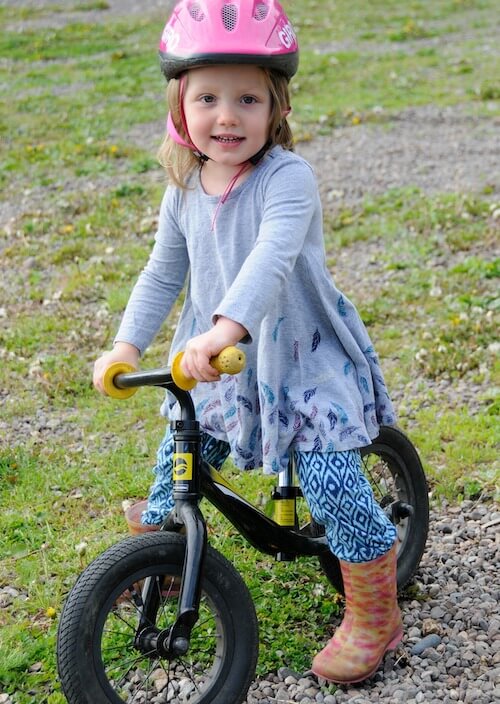
Majority of balance bikes has rubber tires filled with air which cushion the ride a bit and allow your kid to ride over harsher terrains too. There are also balance bikes with thin EVA foam tires which are lighter and puncture-free, but they can handle only smooth surfaces.
| PRO TIP: If you are an adventurous family and want your child to ride on grass or hard-packed sand, it’s best to choose balance bike with pumped tires like Schwinn Skip Toddler Balance Bike or Strider 14X Sport Balance Bike. If you’re looking for extremely lightweight balance bike that even a child can carry, go for a model with foam tires like the JoyStar Kids Balance Bike, Bike Aluminum Balance Bike or TheCroco Lightweight Balance Bike (they weigh around 4-6 pounds). |
But you should keep in mind EVA foam tire wears out quickly, makes turning corners a bit more difficult and the bike may be more wobbly on bumps and cracks in the ground.
Usually balance bikes for toddlers are break-less – which makes them suitable only for flat terrain which no slopes. You can also find balance bike with rear brakes, or even front and rear brakes, but usually these bikes are bigger and suitable from 5 or 6 years. The LittleBig Balance Bike is the only balance bike that I found that is suitable from 2 years, and has rear and front brakes!
It’s important to notice that in general balance bikes have the saddle mounted lower to the ground, that regular pedal bikes because the child needs to keep their feet flat on the ground to be able to walk and run. Majority of balance bikes have a few saddle height settings to adjust to a growing toddler.
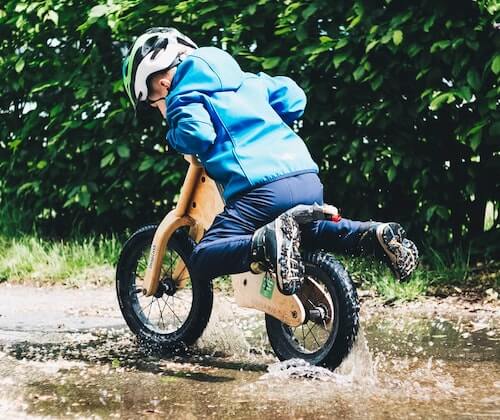
The only thing about balance bikes that parents worry about is how long they are useful, and how quickly you need to switch to pedal bike and spend money again.
Fortunately, balance bike doesn’t have to be an expensive investment. There are good-quality balance bikes for $50-$100. Moreover, most of them are suitable from 1.5-2 years and can serve you even up to 5 years! After that you will need to switch to a bigger balance bike or straight into pedal bike.
There are also convertible balance bikes, which allow you to attach pedals, chain and other equipment, once your child is ready to pedal. Of course, this type is more pricey. Usually it’s a cost of $200 – $250.
| PRO TIP: Some parents ask whether it’s possible to take the pedals off a pedal bike to convert it into a balance bike. Technically it is possible, if you remove the pedals, chains and cranks (it will require some skills to detach it, and then put on again). However, you need to make sure the saddle can be mounted low to allow the toddler keep their feet flat on the ground. And unfortunately, in many cases it won’t be at a proper height for a 2 or 3 year old. Another thing to consider is the bike weight, because regular pedal bikes are usually heavier than balance bikes, meaning they are more difficult to push, maneuver and turn (and in case of a fall, they may hurt the toddler). |
What’s interesting, lots of companies don’t make bikes with stabilisers anymore and have moved onto designing balance bikes.
So, are balance bikes worth it? According to thousands of parents, balance bike is a fantastic investment. Your child can learn how to ride a bike independently, in a safer, easier and fun way with a balance bike. There is no need for stabilisers!
Besides, usually balance bikes and pedal bikes with stabilizers are designed for kids up to 4-5 years, so whichever you choose, you will need to upgrade it for a bigger bike eventually. But in my opinion, the balance bike is a better choice because it supports development of balance and coordination (and boosts child’s confidence) and in the long run, makes learning to cycle easier.
Tricycle Stroller Combo
The third option that I’d like to review here is stroller tricycle combo. What is it?
Basically it’s a stroller with three wheels that turns into a kid trike.
It looks just like a tricycle, but has a parent handlebar, a canopy, and sometime the seat is rotating.
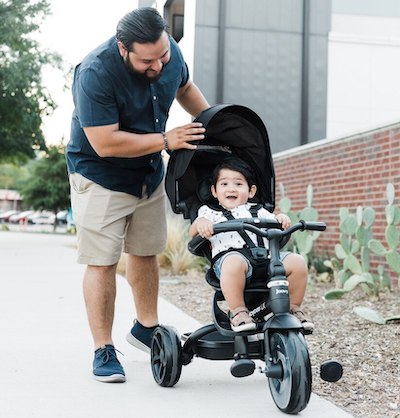
Some tricycle strollers can be used from 6 months, if they have parent-facing seat. Other, with just front-facing seat, are suitable from 9-10 months. In this mode, parents have full control and steer the stroller, the child can rest their feet on a detachable footrest.
As the baby is growing, you can remove each part that is no longer needed – like the canopy, footrest, and eventually parent handle.
Majority of tricycle strollers have a function that allow the child to keep their feet on pedals and even pretend to steer the handle, while it’s the parent who is actually maneuvering the trike stroller.
When the child is ready to pedal and steer, you can remove the handlebar, sometimes you can even detach the seat back, and the stroller turns into a tricycle.

The best thing about tricycle strollers is that they grow with the kid. Parents start to use them with full control over steering and step by step give the child more freedom and independence to cycle on their own.
However, since the trike has 3 wheels, it’s always upright so it won’t teach the child coordination and actually won’t help them practice balance. But it’s good to have that “stroller mode”, before introducing the child to pedaling.
In my opinion, stroller trikes are a great alternative for lightweight strollers for toddlers and bigger kids. It’s a good choice if you are really going to use the “stroller mode” when the baby is few months old. I wouldn’t choose it jus for the “trike mode”.
Training Wheels vs Balance Bike vs Tricycle Stroller – Which One To Choose?

Lots of parents recommend to skip training wheels and invest in a balance bike and then a good quality pedal bike, once the child is ready to cycle. Training wheels are unnecessary, because they actually make the learning process more difficult.
So between balance bike and training wheels, the balance bike is definitely a better choice.
Why balance bike?
Riding on a balance bike has a lots of benefits for the toddler, including development of skills like balance and coordination. Learning to cycle is actually a lot easier with balance bike than it is with a kids pedal bike with stabilisers2.
If I had two choose balance bike vs tricycle (without the “stroller mode”), I would go for the balance bike. It’s just, the thing with tricycles is very similar to training wheels – they don’t teach the child to balance, they don’t help to practice coordination and with small toddlers they are prone to tip over.
However, I find the combination of stroller and trike very useful, if you are going to use the “stroller mode” first. It may be a fantastic alternative to a toddler umbrella stroller, especially for travel, and a fun way to explore surrounding during day trips, visiting Disneyland or the zoo.
But if you are looking for the best way to teach your child to ride a bike, balance bike is the best choice.
Basic Safety Tips For Teaching The Child To Ride A Bike
Lots of parents agree that balance bike is the best help in teaching the child to cycle. But before you introduce your child to balance bike, you may want to give your child a flavor of what it’s like to ride a bike – handlebar seat for infants may be very useful for that (like the one that Thule offers). Once you get the balance bike or pedal bike for your toddler, explain them exactly how it works first, and what the child needs to do to get going and how to stop.
| 1. YOUR LITTLE RIDER MUST WEAR A HELMET EVERY SINGLE TIME. Choose the right size and adjust the straps properly. Remember to give a good example and wear your own helmet when you’re cycling too. |
| 2. Whether you’re using the balance bike or your child is ready to switch to pedal bike, always make sure the vehicle is the correct size. With the balance bike, toddler should be able to keep his feet flat on the ground with knees slightly bent. Your little rider should be able to lean the bike from side to side. On the other hand, with a pedal bike, you need to adjust the saddle height properly (a bit higher than on the balance bike), so the child reaches the pedals conveniently and doesn’t have to bend their knees too much. With a beginner rider, the saddle may be slightly lower allowing the child to touch the ground with the ball of the foot. For more experienced rider you can raise the saddle so the passenger can reach the ground with their tip toes. Children grow really fast so make sure to check and adjust the saddle height every month or two. It’s important to adjust the handlebar height (and geometrics, if possible) too, so the rider has slightly bent elbows and leans forward a bit. It’s not a good idea to get a bigger bike than the child is ready for, because it won’t be comfortable and safe for him. |
| 3. Remember about bike maintenance. Check brakes, tires, chains and all bearing frequently and make any necessary repairs. It’s important to clean the bike properly too, to avoid any rust and mold. |
| 4. Introduce your child to rules of the road. When you’re crossing a road or waiting at traffic lights explain the rules to your kiddo. Again, give a good example and follow the rules of the road too. |
| 5. Choose flat surfaces with no obstacles first. If you want to support your little rider on a pedal bike, it’s better to hold their shoulders or hold them under their armpits or gently push the back of the saddle. Don’t hold bike handlebar, as it could interfere with steering. |
| 6. Always make sure your child feels comfortable, convenient and secure. Give them plenty of encouragement and be a good example. Remember that riding a bike should be an enjoyable and safe activity for both of you! |
The purpose of this article is informative. It’s not a substitute for medical consultation or medical care. Remember: safety first! The author of this article does not accept any responsibility for any liability, loss or risk, personal or otherwise, incurred as a consequence, directly or indirectly, from any information or advice contained here. The article contains affiliate links – your support helps us run this blog!
Source of pictures:
Pictures of Doona Liki Trike belong to Doona. Source: https://www.shopdoona.com/
Pictures of Bentley trike belong to Bentley Motors. Source: https://bentleytrike.com/
Pictures of Joovy Tricycoo LX belong to Joovy. Source: https://joovy.com/

